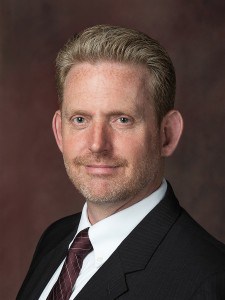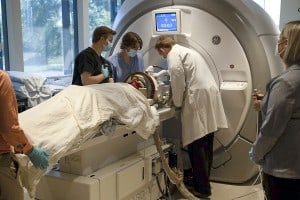Focused Ultrasound can treat hand tremors with no incision and no hospital stay. Instead, it uses sound waves to treat the part of the brain responsible for tremor.
Patients are fitted with a helmet-like device and lie on a treatment table that moves in and out of an MRI for about three hours. They are awake and alert throughout the procedure.
When it’s over, most patients experience immediate, lasting tremor relief and are able to go home the same day.
A state-of-the-art treatment to relieve hand tremors in essential tremor and tremor-dominant Parkinson’s disease patients – with no incision or hospital stay – is now available at Regional One Health’s East Campus Imaging Center.
Focused ultrasound uses MRI technology to guide ultrasound waves to treat the part of the brain that causes tremor. Most patients experience significant, lasting improvement in just a few hours, and because there is no incision, they avoid the risks and difficult recovery of major surgery.
“While essential tremor and Parkinson’s disease are distinct neurological conditions, the focused ultrasound procedure for treating hand tremor symptoms from both is basically the same,” said neurosurgeon Aaron Bond, MD. “Sound waves, under MRI guidance, pass safely through the skull to target the spot in the brain considered to be responsible for tremor.”
While Dr. Bond said focused ultrasound is low-risk and tolerated well by most patients, he realizes any medical procedure can be a source of apprehension. Therefore, he’s offering insight on what to expect before, during and after treatment.
Preparing for focused ultrasound

Dr. Aaron Bond performs the Focused Ultrasound procedure at our East Campus. He said patients typically experience immediate relief from hand tremor and go home the same day.
The focused ultrasound journey begins with a consultation with a neurologist specializing in movement disorders. The treatment is designed for patients 22 and over who have a confirmed diagnosis of essential tremor and have not responded to medication.
Patients who qualify will also need a CT scan to make sure the shape and thickness of their skull is compatible with focused ultrasound treatment.
If a patient does proceed with focused ultrasound, they should plan to spend three or four hours at the Imaging Center for treatment.
What happens during treatment?
When you arrive at the Imaging Center, you will have your head shaved, which allows for the transmission of ultrasound. We’ll also apply a local numbing medication and helmet-like frame to your head to keep your head from moving during the treatment.
You’ll be connected to monitors so your treatment team can track your heart rate, blood pressure and blood oxygen throughout the procedure.
You will be conscious the entire time so you can communicate with the team, but you can take medication to help you stay comfortable. You’ll also be given a “stop” button that lets you signal your team to stop the procedure at any time for any reason.
The upper half of your body will move in and out of the MRI throughout the procedure, but you will need to lie still in one position on the treatment bed over the course of several hours.
The procedure begins with Dr. Bond getting a series of MRI images that let him target treatment to your specific anatomy. Cool water will circulate in the helmet, and he’ll begin applying light doses of ultrasound energy to identify the exact spot in the brain for treatment.
After each application of energy, you’ll be asked to perform tasks like touching your nose with your finger or drawing spirals on a board. This lets Dr. Bond know that he’s targeting the correct spot and the treatment is working.
Once that is confirmed, he’ll apply higher doses of energy to create a therapeutic lesion to treat the tremor. Some patients experience mild pain or nausea, but most report no side effects.

During Focused Ultrasound, patients are fitted with a helmet-like device and lie on a treatment table that moves in and out of an MRI over the course of several hours.
After treatment is complete, your team will do a full MRI to assess the results.
After the procedure
Once the treatment is done, you’ll move to a recovery room and the frame will be removed. Dr. Bond will assess you and let you know when you can go home and when to return for a follow-up visit.
There is a small risk you could develop temporary or permanent muscle weakness, unsteadiness when walking, sensory loss, or numbness or tingling in your fingers or elsewhere. For most patients, side effects are mild or nonexistent and they can return to regular activities within days.
Best of all, Dr. Bond said, most patients report immediate and lasting tremor relief and improved quality of life.
He described how impactful focused ultrasound was for one of his first patients at Regional One Health: “When she came in, she couldn’t feed herself. She couldn’t write. She couldn’t do any of the basic activities of daily living. By the end of the case, her tremor had completely stopped. I saw her in the office three days later, and she told me she’s eating her peas with her fork.”